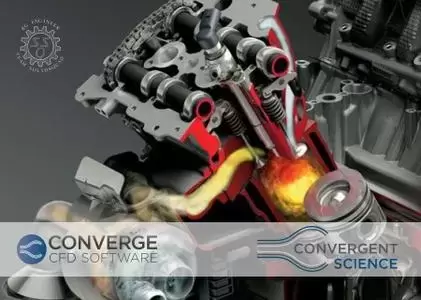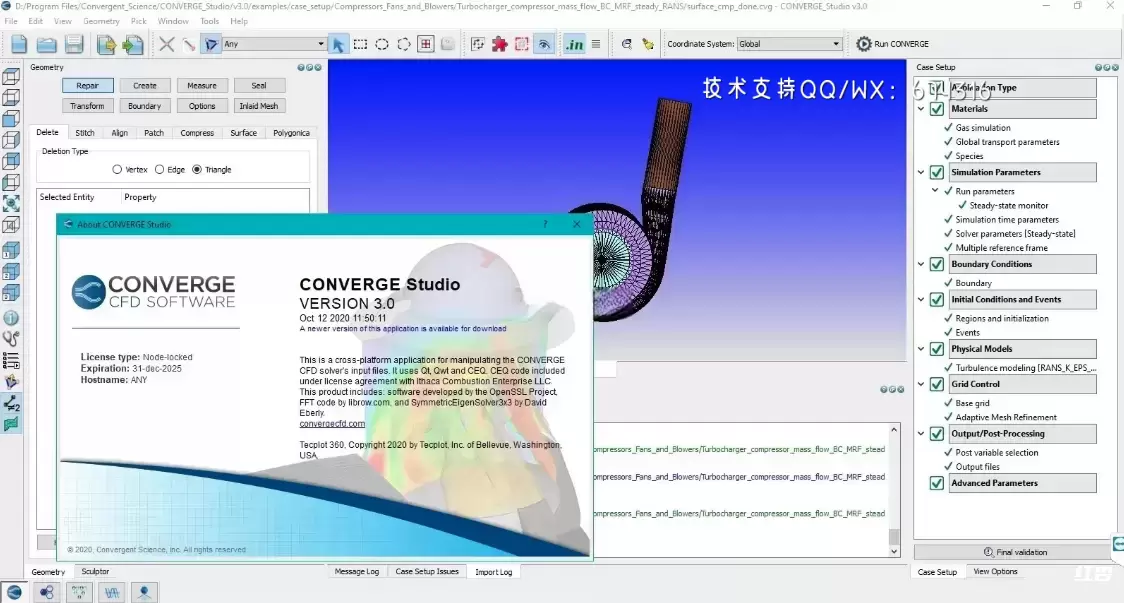CONVERGE Studio 是 Windows 上一款领先的计算流体动力学 (CFD) 软件包,强调准确性、效率和创新性。凭借真正自主的网格划分、最先进的物理模型以及轻松适应复杂移动几何体的能力,CONVERGE 完全有能力帮助您解决难题。CONVERGE 具有完全自主的网格划分功能,可消除仿真过程中所有用户的网格划分时间。此外,CONVERGE 新颖的切割单元方法可以完美地代表您的几何形状(无论多么复杂),并轻松适应移动边界。这种方法避免了网格变形产生的数值粘度,无需密集的手动设置即可提供准确的结果。此外,自适应网格细化允许您在需要的时间和地点添加单元来解决关键流现象,从而有效地为给定的计算费用实现最佳解决方案。
- 电动驾驶汽车建模增强功能,随着道路上电动驾驶汽车数量的增加,设计优化的电池组和电动机变得越来越重要。包括许多新的模型和功能,增强了CONVERGE的电动驾驶汽车建模功能。
- 电池建模,CONVERGE 提供了两种对电池热源进行建模的方法:等效电路模型和电势求解器。使用等效电路模型,您可以将电池表示为电网,并根据电流计算发热。该型号可用于电池充电或放电。电势求解器适用于电池和其他直流电应用,可根据固体的电势和电导率预测电流和相关传热。
- 用于电机设计的 JMAG 联轴器,CONVERGE 3.1增加了与JMAG-Designer耦合的功能,JMAG-Designer是JSOL公司领先的电机设计电磁求解器。JMAG可以为CONVERGE提供由于电磁损耗而产生的热量的真实分布,用于电机冷却模拟。在 CONVERGE Studio 中,您可以直接导入 JMAG NASTRAN 文件。CONVERGE Studio 将读取几何图形并自动分配热边界条件或体积热生成源,以进行共轭传热 (CHT) 仿真。
- 隐式流固耦合建模,当流体和浸没的固体物体的密度相似时,或者当固体漂浮在自由表面上时,流固耦合 (FSI) 仿真可能会变得数值不稳定。CONVERGE 引入了隐式 FSI 建模,克服了这一限制。隐式 FSI 在 CFD 求解器和 FSI 求解器之间实现了内部耦合循环,以更准确地说明流体对 FSI 对象的影响。借助隐式 FSI,CONVERGE 可以准确模拟各种应用,包括海上风力涡轮机的浮动平台、船体和船体以及海底石油和天然气应用。
- 风浪模拟,对于隐式FSI支持的许多海上和海洋应用,能够生成逼真的风场和波浪场对于实现反映现实世界的模拟至关重要。在 CONVERGE 中,波浪生成和合成湍流生成工具可让您轻松模拟规则或不规则的 3D 波,并将逼真的湍流引入风场和波浪场。由于风会影响波浪的动力学,反之亦然,CONVERGE强大的流体建模量,以及几个界面捕获方案,可以解决风波相互作用。
- 系泊模型,海上风力涡轮机和石油和天然气应用的浮动平台通常受到系泊电缆的限制。CONVERGE 中的系泊模型采用有限段法来有效计算系泊缆绳施加的力,然后可用于 FSI 仿真。
- 移动边界更新,在以前的 CONVERGE 版本中,对于墙在单个时间步内可以移动的距离存在限制。在 CONVERGE 中,此限制已被移除 – 墙壁现在可以在一个时间步长内穿过任意数量的像元。虽然设置墙以在时间步长中进一步移动会相应降低精度,但对于某些情况和应用而言,加速可能是值得的。例如,以前依靠多参考系 (MRF) 方法保持运行时合理的旋转案例现在可以更有效地瞬时运行,而不会因 MRF 方法而导致的精度显着损失。
- 移动镶嵌网格,在 CONVERGE 中,我们添加了在仿真域中包含嵌体网格(即非笛卡尔局部网格)的功能。对于某些应用,包括镶嵌网格可以减少计算单元的总数,而不会影响精度。但是,镶嵌网格必须是静止的。在 CONVERGE 中,您现在可以实现移动的镶嵌网格。移动镶嵌网格可用于各种应用,例如准确捕获活塞中的传热,解析飞机机翼襟翼和板条周围的流动,或解析移动的FSI物体周围的流动。对于此类应用,移动镶嵌网格可以帮助以比传统笛卡尔网格更低的计算成本捕获系统的重要物理特性。
- 实体粒子建模,除了CONVERGE长期存在的液相喷雾功能外,CONVERGE 还增加了模拟固体颗粒的能力。这项新功能可用于模拟各种现象和应用,例如烟尘、侵蚀以及颗粒夹带和沉积。
一款功能强大的热流体分析软件,CONVERGE是一种革命性的计算流体动力学(CFD)计划消除了仿真过程中的网格生成瓶颈,该程序是由发动机模拟专家开发,可直接用于发动机和发动机非发动机模拟,与许多CFD程序不同,CONVERGE会自动进行基于简单的用户定义,在运行时生成完全正交的结构化网格网格控制参数,这种网格生成方法完全不需要手动生成网格,此外,程序还提供许多其他功能以加快速度设置过程并确保您的模拟与计算效率相同可能,支持模拟三维,不可压缩或可压缩,瞬态或稳态,化学反应流入具有固定或移动表面的复杂几何形状,程序可以执行计算任何数量的物种和化学反应,以及瞬态液体喷雾和层流或湍流。
CONVERGE Studio 3.x with Solvers | 2.6 Gb
Convergent Science has released the highly anticipated new version of their computational fluid dynamics (CFD) software, CONVERGE 3.0. CONVERGE 3.0 builds on previous versions with new features, enhancements, and expanded capabilities. One of the most notable enhancements in CONVERGE 3.0 is a dramatic improvement in scaling—users will see significant speedup when running the software on large numbers of processors.
“In CONVERGE 3.0, we switched from partitioning the domain on blocks coarser than the solution grid to partitioning the solution grid directly,” says Keith Richards, co-owner of Convergent Science and one of the principal developers of CONVERGE. “This allows us to get a good load balance for any solution mesh, including those with very high levels of embedding, and means CONVERGE scales well even on thousands of cores.”
The way CONVERGE stores information during simulation runtime has also been modified in version 3.0, resulting in a greatly reduced memory footprint. Additionally, CONVERGE’s post-processor, Tecplot for CONVERGE, is more seamlessly integrated into the software, creating a smoother workflow for users.
CONVERGE 3.0 offers more flexibility in meshing than previous versions. With autonomous meshing, CONVERGE automatically generates an optimized Cartesian mesh at runtime. In 3.0, users can optionally incorporate an inlaid mesh in a region of the grid to obtain accurate results with fewer cells. Inlaid meshes can be aligned with the flow direction to reduce numerical viscosity, or users can refine the mesh in only one or two directions instead of all three. This allows users to accurately resolve boundary layers, for example, at a reduced computational cost by increasing mesh resolution only normal to the wall.
Among the new features in CONVERGE are two new combustion models. The thickened flame model for use in conjunction with LES (TFM-LES) is useful for simulations with large differences in length scales, like resolving the flame front in a boiler. The second new model, SAGE PDF, accounts for turbulence-chemistry interactions in flames modeled with RANS.
CONVERGE’s chemistry capabilities have also been enhanced in version 3.0. The SAGE detailed chemistry solver has seen significant speedup, especially for large reaction mechanisms, making CONVERGE one of the fastest chemistry solvers on the market. In addition, CONVERGE 3.0 includes numerous new chemistry tools, including new 0D chemical reactors, a new 1D flamespeed solver, and enhanced tools for manipulating chemical mechanisms.
CONVERGE is a revolutionary computational fluid dynamics (CFD) program thateliminates the grid generation bottleneck from the simulation process. CONVERGE wasdeveloped by engine simulation experts and is straightforward to use for both engine andnon-engine simulations. Unlike many CFD programs, CONVERGE automaticallygenerates a perfectly orthogonal, structured grid at runtimebased on simple, user-definedgrid control parameters. This grid generation method completely eliminates the need tomanually generate a grid. In addition, CONVERGE offers many other features to expeditethe setup process and to ensure that your simulations are as computationally efficient aspossible.
CONVERGE CFD software comprised of the CONVERGE solver, the CONVERGE Studio graphical user interface (GUI), and CONVERGE chemistry tools.
CONVERGE Solver
The CONVERGE solver is designed for solving reacting flows in systems with complex geometries and moving parts. One of the key features of CONVERGE is ‘autonomous meshing’, in which CONVERGE automatically creates and refines the computational mesh, thereby taking the meshing process out of the users’ hands. CONVERGE’s autonomous meshing features include automatic mesh generation and Adaptive Mesh Refinement.
CONVERGE Studio
The CONVERGE Studio GUI includes both pre- and post-processing tools for the CONVERGE solver. Before running a CFD simulation in CONVERGE, the CONVERGE Studio pre-processing tools can be used to prepare the surface geometry, configure input files, and set up the reaction mechanism. After running a CONVERGE simulation, the line plotting module and the 3D visualization module in CONVERGE Studio can be used to visualize and interpret the simulation results.
CONVERGE Chemistry Tools
CONVERGE includes a number of chemistry tools for the SAGE detailed chemistry solver. These tools include the 0D solver, 1D solver, mechanism reduction, mechanism merge, mechanism tuning, and surrogate blender. The 0D, or autoignition, solver calculates ignition delay for a given set of fuel parameters, e.g., temperature, pressure, equivalence ratio. The 1D solver calculates laminar flame speeds.To reduce computational time, the mechanism reduction tool eliminates species and reactions that have the least effect on the simulation results. The mechanism merge tool combines two reaction mechanisms into one,and the mechanism tuning tool optimizes reaction mechanisms to meet specified performance targets. In CONVERGE Studio, the surrogate blender tool approximates real fuels through multi-component surrogates whose properties match those of the target fuel.
Although earlier versions of CONVERGE show good runtime improvements with increasing core counts, speedup is limited for cases with significant local embeddings. CONVERGE 3.0 has been specifically developed to run efficiently on modern hardware configurations that have a high number of cores per node.
With CONVERGE 3.0, we have observed an increase in speedup in simulations with as few as approximately 1,500 cells per core. With its improved scaling efficiency, this new version empowers you to obtain simulation results quickly, even for massive cases, so you can reduce the time it takes to bring your product to market.

Founded in 1997 by graduate students at the University of Wisconsin-Madison, Convergent Science was a CFD consulting company in its early years. In 2008, the first CONVERGE licenses were sold and the company transitioned to a CFD software company. Convergent Science remains headquartered in Madison, Wisconsin, with additional offices in the United States, Europe, and India and distributors around the globe. Our flagship product, CONVERGE CFD, is a revolutionary CFD software that eliminates the grid generation bottleneck from the simulation process.
Product: CONVERGE Studio
Version: 3.x
Supported Architectures: x64
Language: english
System Requirements: PC *
Size: 2.6 Gb
